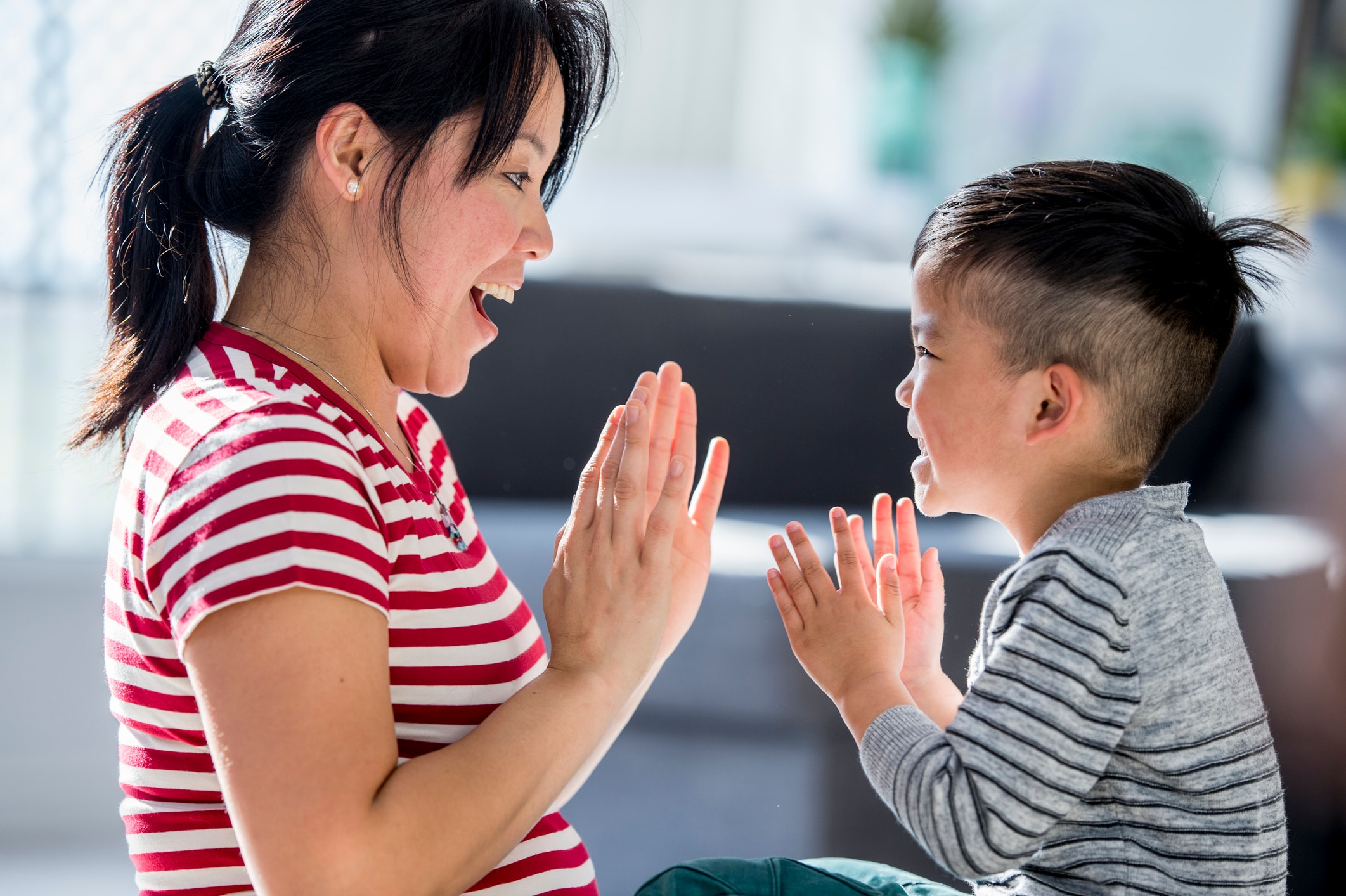For adults, January 1 is the magical day when many of us swear we’re going to start exercising more, save money and stop staying up so late binging Netflix. Of course, about 91% of people fail in those endeavors. New Year’s resolutions are notoriously hard to stick to, even for grown-ups, so what should you do when your kids want to experiment with making their own?
New Year’s resolutions for kids may seem like a convenient way to teach the importance of setting goals, but it’s not unreasonable to worry that making resolutions might also set kids up for failure or cause unnecessary stress. “Kids and people of all ages can set goals that are too broad and expectations that are too high,” says Ellen Kolomeyer, a licensed clinical psychologist and the owner of Unpolished Parenthood in Florida. “We don’t always have a plan to make our resolutions lasting and meaningful, and that can be really discouraging.”
Kolomeyer says it’s not inherently harmful for kids to make New Year’s resolutions, but parents need to play an active role in helping them determine what’s age-appropriate, feasible and healthy. If your kids have resolutions in mind for 2023, here’s what she and other mental health experts recommend to set them up for success.
Do New Year’s resolutions actually help kids?
At its core, a “New Year’s resolution” is just a fancy name for a goal. While the experts agree that teaching kids about healthy goals is important, they also say resolutions aren’t necessarily the best way to go about it. “I’m much more in favor of teaching healthy goal setting all throughout the year,” says Michael Wusik, a licensed clinical psychologist with Dynamic State Behavioral Health in Tampa, Florida. “New Year’s resolutions feel too big, and we can forget by February what the goal even was.”
“New Year’s resolutions feel too big, and we can forget by February what the goal even was.”
—Michael Wusik, clinical psychologist
Besides setting New Year’s resolutions for kids, the experts recommend alternatives to teach healthy goal setting, such as:
- Making a family goal, like trying a new food weekly or signing up for a fun run.
- Setting a weekly intention.
- Choosing a word to act as a theme for the year.
- Choosing a theme song for the year.
That said, if you or your kids are committed to the idea of making New Year’s resolutions, here’s how to guide the conversation.
How to help set healthy New Year’s resolutions for kids
1. Let kids take the lead
“The most important part of setting goals with kids of any age is making sure they are part of the process,” says Gene Dockery, a licensed professional counselor at Affirming Pathways Psychotherapy in Newark, Ohio. “Without their consent and involvement, it is not a goal but a chore.”
When talking to young kids about resolutions, Kolomeyer says to explore their ideas using “I wonder” statements, like:
- “It’s a new year, so we have an opportunity to make something better in our lives. I wonder if you have any ideas in mind?”
- “I think mom’s going to work on this goal. I wonder if you have something you want to work on?”
- “I would love for all of us to be active this year. I wonder what you think would be fun to do together?”
With older kids, Wusik suggests starting the conversation by sharing your own intentions for the year, and then talking about their goals with a tone of “support and encouragement.” He suggests asking questions like:
- “What are you working on?”
- “How can I help you with this in the next year?”
- “Do you just want me to be a cheerleader or is there something I can do to put things in place for you?”
“When I’m helping children create goals, I always discuss their strengths and growth areas with them first. It’s easy for a resolution to be based on perceived deficits. When a goal is strengths-based, it’s empowering.”
—Gene Dockery, licensed professional counselor
2. Focus on strengths, not weaknesses
“When I’m helping children create goals, I always discuss their strengths and growth areas with them first,” Dockery says. “It’s easy for a resolution to be based on perceived deficits. When a goal is strengths-based, it’s empowering.”
Strengths-based goals might include learning more about something they’re interested in, putting more time into a skill or hobby or using their interests and abilities to help others. “The message should never be that they have to make up for some sort of problem,” Wusik adds. “It should be, ‘Hey, you’re doing well, so how can we keep growing? How can we make your life even better than it already is?’”
3. Make it attainable
Experts agree that New Year’s resolutions for kids should be age-appropriate and based on things they’re genuinely capable of doing. For younger kids, Donna Whittaker, an early childhood educator and vice president of curriculum and education at Big Blue Marble Academy, says small, actionable goals are best. “Instead of the goal of never being mad at their sister, suggest the more attainable goal of not hitting her when she takes their toy and saying, ‘I was using that. Please give it back,’” she says.
With older kids, Wusik suggests the S.M.A.R.T. goal model, in which goals are assessed based on whether they are:
- Specific
- Measurable.
- Attainable.
- Realistic.
- Timebound.
“Often, I’ll have kids imagine themselves a year from now, and I’ll ask, ‘What would you have to be doing in a year to feel excited or proud? Is it that you’re playing an instrument, doing well in sports, looking at colleges?’ Once we know what it is, we can start working backwards to what we can do today to put them on that path,” Wusik says.
One important thing to remember: New Year’s resolutions for kids should never be focused on dieting or weight loss. “Goals around food, weight loss and exercise can be dangerous for kids and their relationship with their bodies,” Dockery says.
4. Find the “why”
Healthy goals should be rooted in what kids value and what matters to them. As kids make New Year’s resolutions, Dockery says you and your child should have conversations about:
- Why a particular goal is important.
- Why they want to try for that goal.
- What is motivating them to set the goal.
- What will happen if they do not complete it.
“There are two viewpoints I teach parents: mastery orientation and performance orientation,” adds Wusik. “In a performance mindset, we want to look better to other people. In a mastery mindset, we want something because we value it. I always encourage parents to ask: ‘Is my child comparing themselves to themselves or to the person next to us?’ We want kids to be focused on the process of building themselves.”
“Resolutions are often broad and overarching. One of the best ways to make progress is to break it down into smaller pieces.”
— Gene Dockery
5. Have a plan
“Resolutions are often broad and overarching,” says Dockery. “One of the best ways to make progress is to break it down into smaller pieces. One example might be a resolution to get better at reading. This could be broken down into reading one book a month or reading a certain number of minutes every week.”
Kolomeyer suggests incorporating check-ins and visual aids to set kids up for success. “Put up a family checklist, and then everybody gets to put a checkmark or a sticker on the list,” she says. “Schedule time to talk about achievements and setbacks. Having a regular discussion about your progress increases communication, motivation, accountability, and it gives you an opportunity to explore any problems.”
6. Don’t forget about fun
“A lot of times we go into goal setting with a focus on productive things, like school, and it gives the message that self-care, relaxation and fun aren’t important,” Wusik says. Instead of only focusing on things kids need to do, spend time talking about goals related to things they want and like to do.
“Ask, ‘Where is your fun coming from?’ If they like skateboarding, what’s their goal for skateboarding? What’s the trick they’re going to practice? Show that things they enjoy have equal footing with everything else,” adds Wusik. “That gives them the message that ‘I don’t just respect your school life or your athletic life. I respect you as someone who has interests and likes to have fun. I’m interested in you as a human.’”
7. Acknowledge their successes
“Throughout the day, notice and comment on how children are doing with accomplishing their goals,” Whittaker says. “For example: ‘I noticed when your sister took your toy, you took a deep breath and said, ‘I was using that. Give it back, please.’ I knew you could do it!”
Kolomeyer says daily praise is key in helping children develop the confidence they need to accomplish new things. “When parents find specific things to praise about their children, like, ‘Hey, I’m noticing you, I see how hard you’re working, I see how you did this great thing,’ that helps them build their self-efficacy,” she says. “Self-efficacy is a huge part of achieving what you set out to achieve. The more confident they feel, the more initiative they’re going to take.”
8. Focus on progress not perfection
“Make sure your child knows that ‘perfect’ is not your expectation,” says Dockery. “There will be times in the next year where they have to prioritize other goals or take breaks. This is okay and expected. Twelve months is a long time.”
If you’re worried New Year’s resolutions for kids might cause stress, Kolomeyer says giving kids a small glimpse of your own challenges can help fight against the pull of perfectionism. “Show them that even adults aren’t perfect,” she says. “Maybe you planned to go for a walk three times a week, but you only managed to do it once. That’s a great lesson in being gentle with yourself. You might say, ‘I meant to walk three times, but I only went once. I’m a little disappointed, but that’s OK. I still accomplished something, and next week is a new week.’”
9. Make “quitting” an option
Sometimes the things we set out to accomplish just don’t work out or we realize our plans were way too ambitious. In those cases, it’s OK to pull back, take breaks, change the goal or even scrap it completely, notes Dockery.
“Goals can change if they are not giving or teaching us what we need,” they explain. “If a resolution is doing more harm than good, it can be shifted. A tactical retreat is not quitting. If your child is miserable or completely overwhelmed, it is OK to decide that this was not a good plan. Teaching children to listen to themselves and know their limits is an equally important life skill.”





